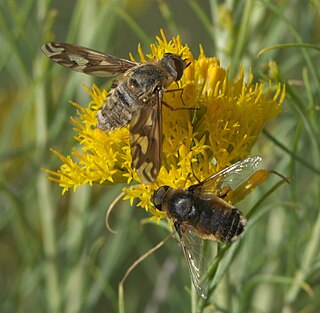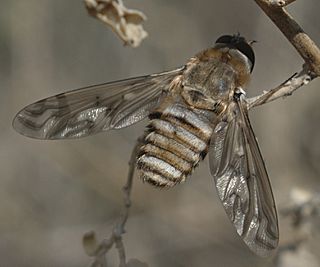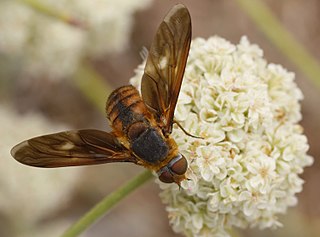
The Bombyliidae are a family of flies, commonly known as bee flies. Some are colloquially known as bomber flies. Adults generally feed on nectar and pollen, some being important pollinators. Larvae are mostly parasitoids of other insects.

Poecilanthrax willistonii, Williston's bee fly or sand dune bee fly, is a member of the Bombyliidae insect family. This family includes the bee flies, true flies that have developed Batesian mimicry characteristics to avoid predators. That is, they look like bees because that helps them avoid bee-wary predators, but they lack stingers.

Poecilanthrax is a large, primarily Nearctic genus of flies belonging to the family Bombyliidae.

Ligyra is a genus of bee flies in the Bombyliidae family. It was described by Edward Newman in 1841. There are at least 110 described species in Ligyra.

Anthracinae is a subfamily of bee flies in the family Bombyliidae. There are more than 80 genera and 2,000 described species in Anthracinae.

Poecilanthrax eremicus is a species of bee fly in the family Bombyliidae.

Villini is a tribe of bee flies in the family Bombyliidae.
Lepidanthrax rauchi is a species of bee fly in the family Bombyliidae. It is found in Mexico and Arizona.

Lepidanthrax is a genus of bee flies in the family Bombyliidae. There are at least 50 described species in Lepidanthrax. The genus is primarily North and Central American, but one species is recorded from the Galapagos Islands and two are recorded from Australia.
Lepidanthrax disjunctus is a species of bee fly in the family Bombyliidae. It is known from Mexico and Arizona.
Dolichomyia gracilis is a species of bee flies.
Rhynchanthrax parvicornis is a species of bee flies. It is found in the central United States from New Mexico to Alabama, north to Iowa.
Ogcodocera analis is a species of bee fly in the family Bombyliidae. It is found in Mexico, Arizona, and Texas.
Ogcodocera is a North American genus of bee flies in the family Bombyliidae. There are two described species in the genus Ogcodocera.
Lepidanthrax californicus is a species of bee fly in the family Bombyliidae. It is known from California, Arizona, and Baja California Norte.

Geron is a genus of bee flies in the family Bombyliidae. There are at least 180 described species in the genus Geron, found on every continent except Antarctica.
Lepidanthrax linsdalei is a species of bee fly in the family Bombyliidae. It is known from California and Idaho.
Lepidanthrax oribates is a species of bee fly in the family Bombyliidae. It is widespread in the western United States from California and Nevada north to British Columbia, Canada.
Lepidanthrax arnaudi is a species of bee fly in the family Bombyliidae. It is found in California.
Lepidanthrax angulus is a species of bee fly in the family Bombyliidae. It is found in Mexico and the southwestern United States.








